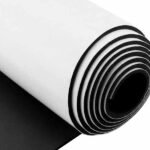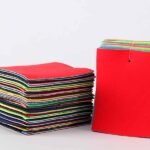Lunch bags are an essential accessory for people who prefer to bring their meals to work, school, or outdoor activities. Among the many options available, neoprene lunch bags stand out for their unique features and growing popularity. If you’re considering investing in a neoprene lunch bag or adding them to your product lineup, it’s natural to wonder: do they really work?
Neoprene lunch bags are effective for keeping food fresh and maintaining its temperature. Their insulating properties, durability, and versatility make them a great choice for both personal use and commercial customization.
Let’s explore the benefits, functionality, and care of neoprene lunch bags to see why they’re a reliable choice for your needs.
What Are Neoprene Lunch Bags?
Neoprene lunch bags are reusable bags made from neoprene, a synthetic rubber material known for its flexibility, durability, and insulation. These bags are designed to keep food and drinks at their desired temperature while being lightweight and easy to carry.
Neoprene lunch bags are functional, stylish, and versatile, offering insulation and protection for meals during transport. They are available in various sizes and customizable designs, making them ideal for personal use and brand promotion.
The neoprene material stands out because it can stretch to fit containers of different shapes and sizes while maintaining its insulating properties.
Features of Neoprene Lunch Bags
- Insulation: Keeps food and drinks at the right temperature for hours.
- Durability: Resistant to wear and tear, suitable for daily use.
- Water Resistance: Protects contents from external moisture.
- Customizable: Perfect for adding logos, patterns, and colors.
What is the best material for an insulated lunch bag?
Choosing the right material for an insulated lunch bag is crucial for ensuring that food stays fresh and at the desired temperature. Materials like neoprene, polyester, and foil-lined fabrics are common, but each has unique advantages.
Neoprene is one of the best materials for insulated lunch bags due to its superior thermal insulation, water resistance, and durability. Unlike polyester or foil-lined bags, neoprene offers both functionality and flexibility.
Neoprene outperforms other materials in terms of longevity and resistance to stains or odors, making it an excellent choice for everyday use.
Comparison of Insulated Lunch Bag Materials
| Material | Pros | Cons |
|---|---|---|
| Neoprene | Excellent insulation, durable, water-resistant | Slightly heavier than polyester |
| Polyester | Lightweight, affordable | Less effective insulation, less durable |
| Foil-lined | Good for short-term insulation | Prone to tearing, harder to clean |
Do neoprene lunch bags keep food cold?
Maintaining the temperature of food is one of the primary purposes of an insulated lunch bag. Neoprene excels in this area thanks to its unique properties.
Neoprene lunch bags can keep food cold for hours when used with an ice pack. The thick, insulating material helps maintain low temperatures by reducing heat transfer.
The combination of neoprene’s thermal resistance and its snug fit ensures that both cold and warm food stay at their optimal temperatures for longer periods.
How to Enhance Temperature Retention
- Use ice packs for better cooling efficiency.
- Avoid opening the bag frequently to retain cold air.
- Store the bag in a shaded, cool area during transport.
Are Neoprene Lunch Bags Durable?
Durability is a critical factor when selecting a lunch bag, especially for daily use. Neoprene lunch bags are built to withstand regular wear and tear without compromising functionality.
Neoprene lunch bags are highly durable, withstanding stretching, impacts, and exposure to moisture. Their construction ensures they last longer than many alternatives.
The material’s resistance to punctures and its ability to maintain shape even after heavy use make neoprene a reliable choice for users looking for a long-term solution.
Factors Contributing to Durability
- Material Strength: Neoprene is inherently tough and elastic.
- Water Resistance: Protects against spills and external moisture.
- Reinforced Stitching: Prevents seams from splitting under pressure.
How to Care for and Maintain Neoprene Lunch Bags?
Proper care can significantly extend the lifespan of neoprene lunch bags. Regular cleaning and mindful storage are essential to prevent odors, stains, and material degradation.
To care for neoprene lunch bags, clean them regularly with mild soap and water, avoid using harsh chemicals, and air dry completely before storage.
By following these simple maintenance steps, users can ensure that their neoprene lunch bags remain fresh, functional, and hygienic for years.
Cleaning Tips for Neoprene Lunch Bags
- Spot Cleaning: Wipe spills immediately with a damp cloth.
- Hand Washing: Use lukewarm water and mild detergent for thorough cleaning.
- Drying: Always air dry in a shaded area to prevent shrinking or warping.
Common Mistakes to Avoid
| Mistake | Consequence |
|---|---|
| Using bleach or harsh chemicals | Weakens the material and causes discoloration |
| Machine drying | May shrink or deform the bag |
| Storing while damp | Leads to mold or unpleasant odors |
Conclusion
Neoprene lunch bags are a practical, durable, and customizable solution for keeping food fresh and insulated. Their unique features, such as superior insulation, water resistance, and flexibility, make them ideal for daily use and promotional purposes. At Szoneier, we specialize in manufacturing high-quality neoprene lunch bags tailored to meet the needs of brand owners, wholesalers, and retailers.
If you’re looking for durable, customizable neoprene lunch bags to add to your product line, contact us today. We offer free samples, fast lead times, and flexible customization options.











